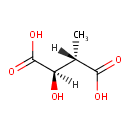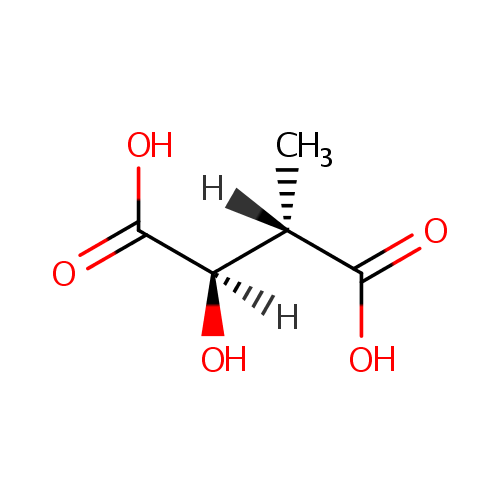|
Record Information |
|---|
| Version |
1.0 |
|---|
| Update Date |
1/22/2018 11:54:54 AM |
|---|
|
Metabolite ID | PAMDB000985 |
|---|
|
Identification |
|---|
| Name: |
D-Erythro-3-Methylmalate |
|---|
| Description: | D-erythro-3-methylmalate is a member of the chemical class known as Dicarboxylic Acids and Derivatives. These are organic compounds containing exactly two carboxylic acid groups. |
|---|
|
Structure |
|
|---|
| Synonyms: | - (2R,3S)-2-hydroxy-3-methylbutanedioate
- (2R,3S)-2-hydroxy-3-methylbutanedioic acid
- (2R,3S)-3-methylmalate
- (2R,3S)-3-methylmalic acid
- D-Erythro-3-methylmalate
- D-Erythro-3-methylmalic acid
|
|---|
|
Chemical Formula: |
C5H8O5 |
|---|
| Average Molecular Weight: |
148.114 |
|---|
| Monoisotopic Molecular
Weight: |
148.037173366 |
|---|
| InChI Key: |
NPYQJIHHTGFBLN-STHAYSLISA-N |
|---|
| InChI: | InChI=1S/C5H8O5/c1-2(4(7)8)3(6)5(9)10/h2-3,6H,1H3,(H,7,8)(H,9,10)/t2-,3+/m0/s1 |
|---|
| CAS
number: |
Not Available |
|---|
| IUPAC Name: | (2R,3S)-2-hydroxy-3-methylbutanedioic acid |
|---|
|
Traditional IUPAC Name: |
D-erythro-3-methylmalate |
|---|
| SMILES: | [H][C@@](C)(C(O)=O)[C@@]([H])(O)C(O)=O |
|---|
|
Chemical Taxonomy |
|---|
|
Taxonomy Description | This compound belongs to the class of organic compounds known as hydroxy fatty acids. These are fatty acids in which the chain bears a hydroxyl group. |
|---|
|
Kingdom |
Organic compounds |
|---|
| Super Class | Lipids and lipid-like molecules |
|---|
|
Class |
Fatty Acyls |
|---|
| Sub Class | Fatty acids and conjugates |
|---|
|
Direct Parent |
Hydroxy fatty acids |
|---|
| Alternative Parents |
|
|---|
| Substituents |
- Hydroxy fatty acid
- Methyl-branched fatty acid
- Short-chain hydroxy acid
- Branched fatty acid
- Beta-hydroxy acid
- Hydroxy acid
- Dicarboxylic acid or derivatives
- Alpha-hydroxy acid
- Secondary alcohol
- Carboxylic acid
- Carboxylic acid derivative
- Hydrocarbon derivative
- Organooxygen compound
- Carbonyl group
- Alcohol
- Aliphatic acyclic compound
|
|---|
| Molecular Framework |
Aliphatic acyclic compounds |
|---|
| External Descriptors |
|
|---|
|
Physical Properties |
|---|
| State: |
Not Available |
|---|
| Charge: | -2 |
|---|
|
Melting point: |
Not Available |
|---|
| Experimental Properties: |
|
|---|
| Predicted Properties |
|
|---|
|
Biological Properties |
|---|
| Cellular Locations: |
Cytoplasm |
|---|
| Reactions: | |
|---|
|
Pathways: |
- C5-Branched dibasic acid metabolism pae00660
- Valine, leucine and isoleucine biosynthesis pae00290
|
|---|
|
Spectra |
|---|
| Spectra: |
|
|---|
|
References |
|---|
| References: |
- Kanehisa, M., Goto, S., Sato, Y., Furumichi, M., Tanabe, M. (2012). "KEGG for integration and interpretation of large-scale molecular data sets." Nucleic Acids Res 40:D109-D114. Pubmed: 22080510
|
|---|
| Synthesis Reference: |
Not Available |
|---|
| Material Safety Data Sheet (MSDS) |
Not Available |
|---|
|
Links |
|---|
| External Links: |
| Resource | Link |
|---|
| CHEBI ID | 27394 | | HMDB ID | Not Available | | Pubchem Compound ID | 440892 | | Kegg ID | C06032 | | ChemSpider ID | 389722 | | Wikipedia ID | Not Available | | BioCyc ID | Not Available |
|
|---|


